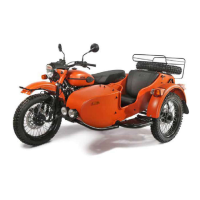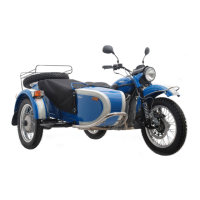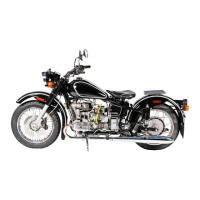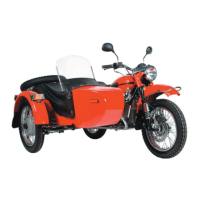Do you have a question about the URAL Motorcycles 2014 Gear up and is the answer not in the manual?
Essential guidelines for performing maintenance and repairs safely and correctly.
Locating and identifying the vehicle's VIN, engine, and gearbox numbers.
Detailed technical specifications for different Ural models.
Precise torque values for various fasteners to ensure secure assembly.
Specifies required gaps for various components like valves and spark plugs.
Details on acceptable play and adjustment procedures for controls.
Information on tire types and recommended inflation pressures.
Scheduled maintenance tasks based on mileage intervals.
Instructions for long-term storage and regular cleaning of the motorcycle.
Description and operation of controls located on the handlebars.
Explanation of the shift lever and rear brake lever operation.
Details on the three-position ignition switch and its functions.
Overview of the instrument cluster including speedometer, odometer, and trip meter.
Explanation of dashboard warning and status indicator lights.
Information on the adjustable steering damper and its settings.
Operation and function of the motorcycle's parking brake.
How to engage and disengage the motorcycle's reverse gear.
Instructions for using the kick starter mechanism.
Operation of the lever to engage or disengage two-wheel drive.
Details on adjusting the preload on the suspension shock absorbers.
Essential checks to ensure the motorcycle is safe before riding.
Guidance for new riders on their first experience with the motorcycle.
Critical safety information specific to operating a sidecar motorcycle.
Additional safety advice and practice maneuvers for sidecar operation.
Step-by-step instructions for starting the engine when cold or hot.
Guidelines for breaking in the engine during the initial period of use.
Specifies types and quantities of fluids and lubricants needed.
Visual guide showing lubrication points on the motorcycle.
Detailed list of all lubrication points and their corresponding types.
Procedure for changing the engine oil and replacing the oil filter.
Steps for draining and refilling the gearbox oil.
Instructions for changing the final drive oil.
Guidance on lubricating drive shafts and wheel splines.
Procedure for lubricating all control cables.
Procedure for checking and replacing the air filter element.
Steps for maintaining the fuel system, including filter replacement.
Process for checking and adjusting valve clearances.
Instructions for servicing the front brake pads and fluid.
Procedure for maintaining the rear brake pads and fluid.
Steps to properly adjust the parking brake cable.
Procedure for servicing the sidecar brake pads and fluid.
Detailed steps for removing and installing the front wheel assembly.
Instructions for removing and installing the rear wheel assembly.
Procedure for removing and installing the sidecar wheel.
Guidance on the proper use and installation of the spare wheel.
How to check and adjust wheel spoke tension.
Procedure for replacing wheel bearings and component diagrams.
Steps for replacing motorcycle tires and inner tubes.
Instructions for adjusting sidecar camber, toe-in, and lean-out.
Visual representation of sidecar alignment parameters.
Procedure for replacing the motorcycle's headlight bulb.
Instructions for replacing the tail light and license plate bulbs.
Procedure for replacing turn signal bulbs.
Instructions for replacing bulbs in the sidecar lamps.
Guidelines for maintaining the motorcycle battery's health and performance.
Step-by-step instructions for removing and installing the battery.
Diagrams showing the location and function of all fuses.
Identification of the locations for various electrical relays.
Information on the starter system and its requirements.
Details on the alternator specifications and testing procedures.
Location and purpose of the Engine Control Unit data port.
How to interpret engine management system fault codes.
Additional notes or recommendations related to EFI service.
Details of the manufacturer's warranty terms and conditions.
Exclusions and limitations of the motorcycle warranty coverage.
Specific warranty information related to California emission control systems.
Details on the warranty for emission control system components.
Instructions on how to report safety-related vehicle defects.
Diagram illustrating the motorcycle's crankcase emission control system.
Diagram of the evaporative emission control system for California models.
Information about the emission control label on the motorcycle.
Form for transferring warranty registration for pre-owned motorcycles.
Form to update owner contact information with the manufacturer.
Complete electrical wiring diagram for the motorcycle.
Essential guidelines for performing maintenance and repairs safely and correctly.
Locating and identifying the vehicle's VIN, engine, and gearbox numbers.
Detailed technical specifications for different Ural models.
Precise torque values for various fasteners to ensure secure assembly.
Specifies required gaps for various components like valves and spark plugs.
Details on acceptable play and adjustment procedures for controls.
Information on tire types and recommended inflation pressures.
Scheduled maintenance tasks based on mileage intervals.
Instructions for long-term storage and regular cleaning of the motorcycle.
Description and operation of controls located on the handlebars.
Explanation of the shift lever and rear brake lever operation.
Details on the three-position ignition switch and its functions.
Overview of the instrument cluster including speedometer, odometer, and trip meter.
Explanation of dashboard warning and status indicator lights.
Information on the adjustable steering damper and its settings.
Operation and function of the motorcycle's parking brake.
How to engage and disengage the motorcycle's reverse gear.
Instructions for using the kick starter mechanism.
Operation of the lever to engage or disengage two-wheel drive.
Details on adjusting the preload on the suspension shock absorbers.
Essential checks to ensure the motorcycle is safe before riding.
Guidance for new riders on their first experience with the motorcycle.
Critical safety information specific to operating a sidecar motorcycle.
Additional safety advice and practice maneuvers for sidecar operation.
Step-by-step instructions for starting the engine when cold or hot.
Guidelines for breaking in the engine during the initial period of use.
Specifies types and quantities of fluids and lubricants needed.
Visual guide showing lubrication points on the motorcycle.
Detailed list of all lubrication points and their corresponding types.
Procedure for changing the engine oil and replacing the oil filter.
Steps for draining and refilling the gearbox oil.
Instructions for changing the final drive oil.
Guidance on lubricating drive shafts and wheel splines.
Procedure for lubricating all control cables.
Procedure for checking and replacing the air filter element.
Steps for maintaining the fuel system, including filter replacement.
Process for checking and adjusting valve clearances.
Instructions for servicing the front brake pads and fluid.
Procedure for maintaining the rear brake pads and fluid.
Steps to properly adjust the parking brake cable.
Procedure for servicing the sidecar brake pads and fluid.
Detailed steps for removing and installing the front wheel assembly.
Instructions for removing and installing the rear wheel assembly.
Procedure for removing and installing the sidecar wheel.
Guidance on the proper use and installation of the spare wheel.
How to check and adjust wheel spoke tension.
Procedure for replacing wheel bearings and component diagrams.
Steps for replacing motorcycle tires and inner tubes.
Instructions for adjusting sidecar camber, toe-in, and lean-out.
Visual representation of sidecar alignment parameters.
Procedure for replacing the motorcycle's headlight bulb.
Instructions for replacing the tail light and license plate bulbs.
Procedure for replacing turn signal bulbs.
Instructions for replacing bulbs in the sidecar lamps.
Guidelines for maintaining the motorcycle battery's health and performance.
Step-by-step instructions for removing and installing the battery.
Diagrams showing the location and function of all fuses.
Identification of the locations for various electrical relays.
Information on the starter system and its requirements.
Details on the alternator specifications and testing procedures.
Location and purpose of the Engine Control Unit data port.
How to interpret engine management system fault codes.
Additional notes or recommendations related to EFI service.
Details of the manufacturer's warranty terms and conditions.
Exclusions and limitations of the motorcycle warranty coverage.
Specific warranty information related to California emission control systems.
Details on the warranty for emission control system components.
Instructions on how to report safety-related vehicle defects.
Diagram illustrating the motorcycle's crankcase emission control system.
Diagram of the evaporative emission control system for California models.
Information about the emission control label on the motorcycle.
Form for transferring warranty registration for pre-owned motorcycles.
Form to update owner contact information with the manufacturer.
Complete electrical wiring diagram for the motorcycle.
| Compression Ratio | 8.6:1 |
|---|---|
| Power | 40 hp @ 5600 rpm |
| Bore x Stroke | 78 mm x 78 mm |
| Fuel System | Carburetor |
| Ignition | Electronic |
| Starting | Electric and kick start |
| Transmission | 4 forward, 1 reverse |
| Clutch | Dry, double-disc |
| Final Drive | Shaft |
| Frame | Steel |
| Front Suspension | Telescopic fork |
| Rear Suspension | Swing arm with Sachs hydraulic shock absorbers |
| Front Brake | Drum brake |
| Rear Brake | Drum brake |
| Sidecar Brake | Drum brake |
| Fuel Capacity | 5.0 gallons |
| Maximum Speed | 65 mph |



